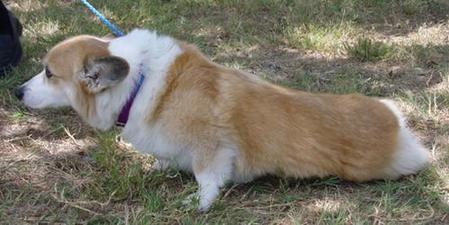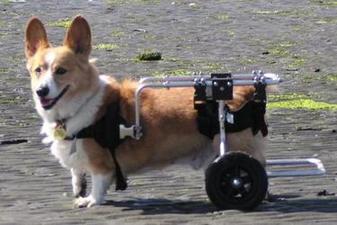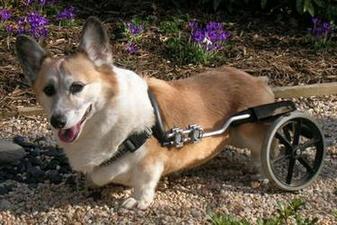Degenerative Myelopathy (DM) in Corgis
What is Degenerative Myelopathy?Degenerative myelopathy is a progressive disease of the spinal cord in older dogs. The breeds most commonly affected include German Shepherds, Welsh Corgis, Irish Setters, and Chesapeake Bay Retrievers. The disease has an insidious onset typically between 8 and 14 years of age. It begins with a loss of coordination (ataxia) in the hind limbs. The affected dog will wobble when walking, knuckle over or drag the feet. This can first occur in one hind limb and then affect the other. As the disease progresses, the limbs become weak and the dog begins to buckle and has difficulty standing. The weakness gets progressively worse until the dog is unable to walk. The clinical course can range from 6 months to 1 year before dogs become paraplegic. If signs progress for a longer period of time, loss of urinary and fecal continence may occur and eventually weakness will develop in the front limbs. Another key feature of DM is that it is not a painful disease.

Degenerative myelopathy is a devastating and heartbreaking disease causing progressive paralysis in a large number of dog breeds. New research has identified a gene that is associated with a major increase in risk of the disease. |
Pembroke Corgis are generally between 8 and 14 years of age when the disease starts but it can progress rapidly - leaving your Corgi unable to walk in 6 to 12 months. The one plus to this disease is that the nerves that control pain disappear along with the nerves to control movement, so your Corgi is not in physical pain with this.
In Cardigans, the onset of DM seems to be slightly later, typically at around age 12 to as late as age 15 or so.
However, most Corgis are not old at 10, 11 and 12 and so it is very distressing when DM is diagnosed and many Corgis seem very upset by the fact that they can no longer get around well.
If you subscribe to the Wheelcorgi-list you will get an idea of what people are going through. That DM is indeed a devastating disease is also confirmed by the fact that there is an annual Wheel-Corgi calendar which is sold to benefit CorgiAid .

What is the cause of degenerative myelopathy?
The exact cause of DM is unknown. Genetics probably plays an important role in the disease since it is common only in certain breeds of dogs and follows a stereotyped pattern with age of onset and clinical signs.
We do know that the disease begins with the spinal cord in the thoracic (chest) area. If we look under the microscope at that area of the cord from a dog who has died from DM, we see degeneration of the white matter of the spinal cord. The white matter contains the fibers that transmit movement commands from the brain to the limbs and sensory information from the limbs to the brain. This degeneration consists of both demyelination (stripping away the insulation of these fibers) and axonal loss (loss of the fibers themselves).
How is DM diagnosed?
Degenerative myelopathy is a diagnosis of elimination. We look for other causes of the weakness using diagnostic tests like myelography and MRI. When we have ruled them out, we end up with a presumptive diagnosis of DM. The only way to confirm that suspicion, however, is to examine the spinal cord under the microscope when a necropsy (post-mortem exam) is performed. There are characteristic degenerative changes in the spinal cord, which tell us this is DM and not some other spinal cord disease.
What else can cause similar symptoms?
Any disease that affects the dog's spinal cord can cause similar signs of loss of coordination and weakness. Since many of these diseases can be treated effectively, it is important to pursue the tests necessary to be sure that the dog doesn't have one of these diseases. The most common cause of hind limb weakness is herniated intervertebral disks (slipped disks). The disks are shock-absorbers between the bones of the back. When they herniate, they can cause pressure on the spinal cord and weakness or paralysis. All of the short-legged dogs (Welsh Corgi, Dachshund, Basset Hound, etc.) are prone to slipped disks. A slipped disk can usually be detected with special X-rays of the spine (myelogram), but sometimes more advanced studies such as a CT or MRI scan are necessary. Even dogs with severely slipped disks can often be helped with surgery if diagnosed early.
Infections of the spinal cord can also cause weakness or paralysis. A spinal tap, usually taken at the time the myelogram is performed, can help detect inflammation of the spinal cord. Other diseases we consider include tumors, cysts, injuries and strokes. The combination of myelogram, spinal tap, and possibly CT or MRI allow us to diagnose most of these diseases.
How do we treat degenerative myelopathy?
There are no treatments that have been clearly shown to stop or slow progression of DM. Although there are a number of approaches that have been tried or recommended on the internet, no scientific evidence exists that they work. The outlook for a dog with DM is still grave. Things that can improve the quality of life for the dog include good nursing care, physical therapy, pressure sore prevention, monitoring for urinary infections, and ways to increase mobility through use of harnesses and carts.
Caution: Never, ever, hold or attempt to hold a DM dog up by its tail!!! To do so, can cause great harm to a DM dog!! Holding a DM dog up, supporting it, or lifting it by the tail can break the tail. Please, do not do this to your DM dog. By doing so, you put your dog in grave danger and in harm's way. DM is a terribly destructive disease without complicating it by ignorant and thoughtless actions.
 |
 |
DNA-Test for DM
Dr. Gary Johnson at the Animal Molecular Genetics Laboratory and Dr. Joan Coates at the Comparative Neurology Program of the University of Missouri and Drs. Claire Wade and Kerstin Lindblad-Toh at the Broad Institute of MIT/Harvard and their colleagues have identified a DNA mutation that is a major risk factor for development of degenerative myelopathy in dogs.
A DNA test for DM is now available for Pembroke and Cardigan Welsh Corgis as well as for some other breeds. This test is available through the OFA (Orthopedic Foundation for Animals). The test clearly identifies dogs that are clear, those who are carriers and those who are at much higher risk for developing DM. Obviously other factors are also involved since not all dogs with 2 mutated copies of the gene develop DM (or perhaps die of something else before they develop DM).
Explanation of DNA Test Results
Normal (N/N)
This dog is homozygous N/N, with two normal copies of the gene. This dog can only transmit the normal gene to its offspring and does not develop DM.
Carrier (A/N)
This dog is heterozygous A/N, with one mutated copy of the gene and one normal copy of the gene, and is classified as a carrier. This dog does not develop DM but can transmit either the normal gene or the mutated gene to its offspring.
At-Risk (A/A)
This dog is homozygous A/A, with two mutated copies of the gene, and is at risk for developing Degenerative Myelopathy (DM). The research has shown that all dogs in the research study with confirmed DM have had A/A DNA test results, however, not all dogs testing as A/A have shown clinical signs of DM. DM is typically a late onset disease, and dogs testing as A/A that are clinically normal may still begin to show signs of the disease as they age. Some dogs testing A/A did not begin to show clinical signs of DM until they were 15 years of age. Research is ongoing to estimate what percentage of dogs testing as A/A will develop DM within their lifespan. At this point, the mutation can only be interpreted as being at risk of developing DM within the animal's life. For dogs showing clinical signs with a presumptive diagnosis of DM, affected (A/A) test results can be used as an additional tool to aid in the diagnosis of DM. Dogs testing At-Risk (A/A) can only pass the mutated gene on to their offspring.
This late onset is why dogs who have two genes for DM are described as 'at risk' rather than 'affected', because many dogs who test as 'at risk' may die of some other problem before they are old enough to develop symptoms of DM.
It is important to note that there are a large number of dogs that have tested as genetically affected, but are reported as clinically normal by their owners. It may be that many of these dogs will develop clinical signs as they get older or that the mutation will never manifest in these dogs.
The DNA marker for DM in dogs is the same genetic marker which is known to cause ALS (Lous Gerrig's disease) in some humans.
OFA Results from 1974-2019
| Pembroke Welsh Corgi | |
| At risk | 53.7% |
| Carrier | 33.8% |
| Clear | 12.6% |
| Total tested | 4119 |
| Cardigan Welsh Corgi | |
| At risk | 17.1% |
| Carrier | 34.8% |
| Clear | 48% |
| Total tested | 735 |
How to order the DNA test
Tests are ordered online through the secure area of the OFA website. Payment is accepted online by credit card (MasterCard and VISA). The OFA administers all order handling. Upon receipt of an order, the OFA will send out the test kit which will include an FTA card for DNA sample collection, along with sample collection instructions. Using the FTA card technology, owners can safely collect DNA samples at home. The collection process is non-invasive, and no veterinary appointment is necessary.
Samples are then sent to the University of Missouri College of Veterinary Medicine where the samples will be processed by the Small Animal Molecular Genetics Lab. Results will be forwarded to the OFA, and the OFA will issue the resulting report to the owner. The fee for each test is $65 and includes the test kit, laboratory processing, and subsequent registration in the OFA databases.
In Europe DM tests can be carried out by Laboklin
 "Corgis on Wheels" written
by Bobbie Mayer is a complete guide to understanding and caring
for the special needs of Corgis with Degenerative Myelopathy (DM)
or Intervertebral Disk Disease (IVDD). The book is available from
www.corgiaid.org/cart/corgisonwheels at a price of
USD 25.00 plus shipping
"Corgis on Wheels" written
by Bobbie Mayer is a complete guide to understanding and caring
for the special needs of Corgis with Degenerative Myelopathy (DM)
or Intervertebral Disk Disease (IVDD). The book is available from
www.corgiaid.org/cart/corgisonwheels at a price of
USD 25.00 plus shipping
Current reasearch (2014) in DM
22.05.2020
